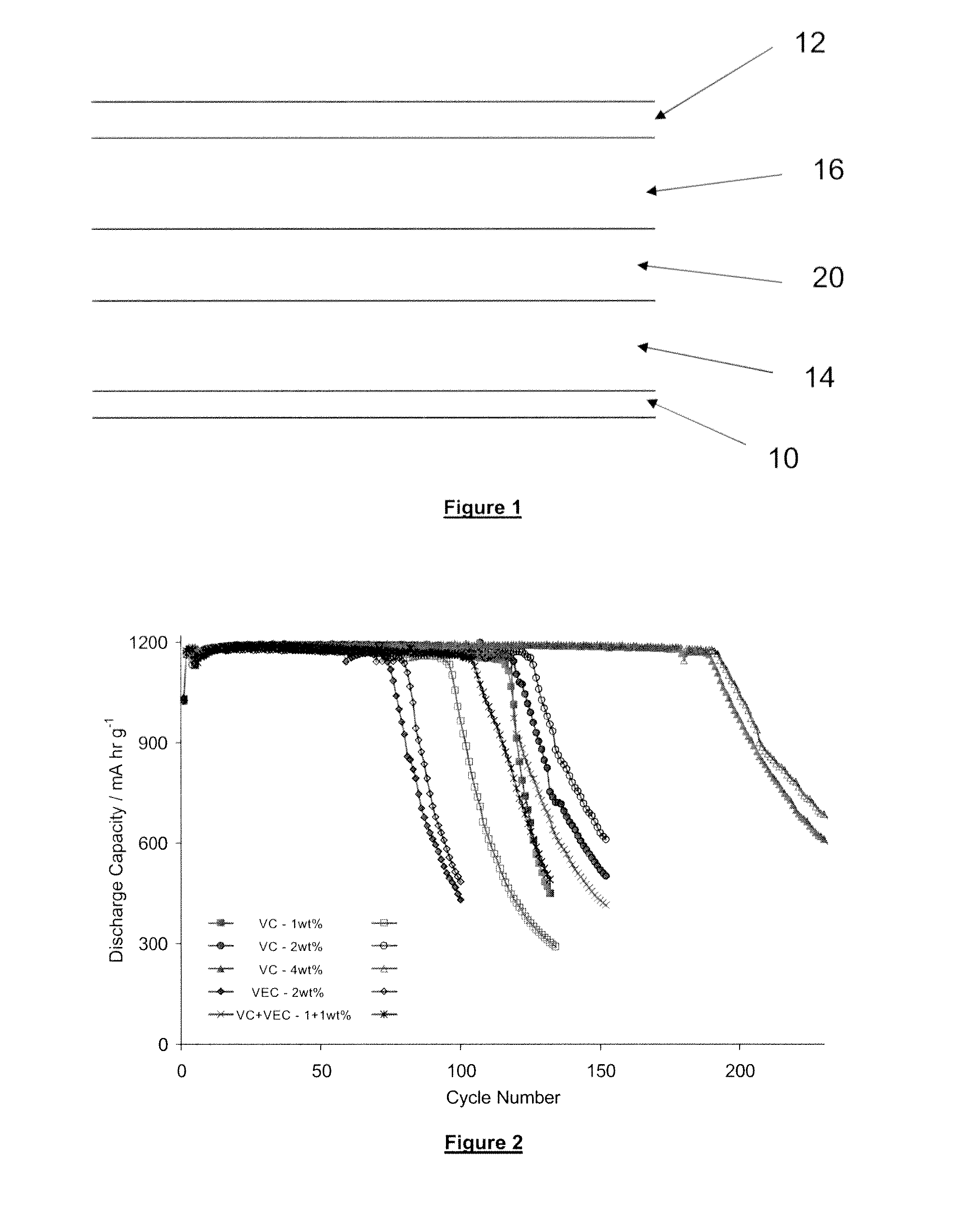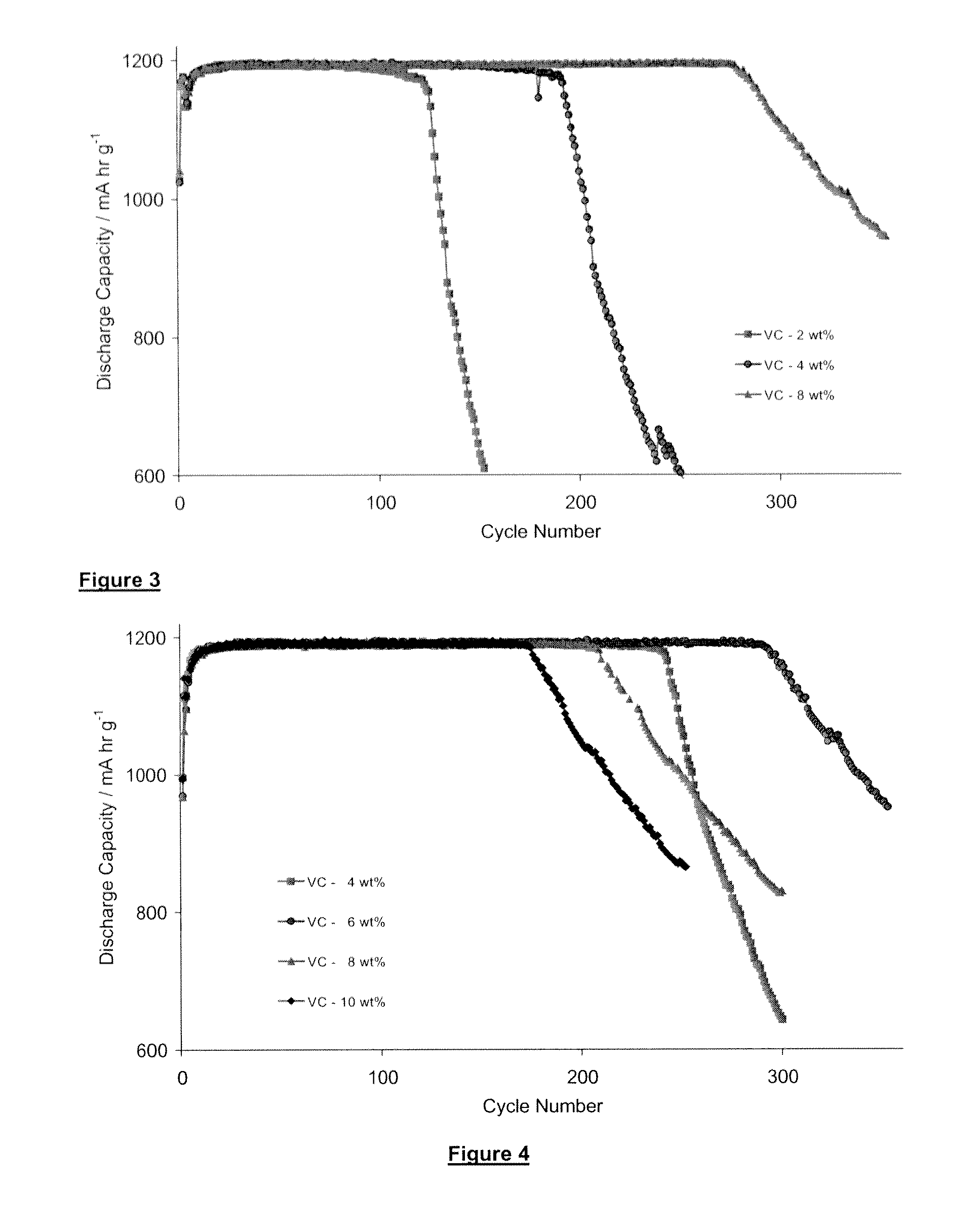Additive for lithium ion rechageable battery cells
a lithium ion rechargeable battery and additif technology, applied in secondary cells, non-aqueous electrolyte cells, cell components, etc., can solve the problems of increasing the likelihood of structural breakdown of the active material of the anode during expansion and contraction, the volume change of the silicon anode material in the li-ion cell, and the short cycle life of the electrode, so as to reduce the resistance of the anode, increase the conductivity, and increase the electrical conductivity of the anod
- Summary
- Abstract
- Description
- Claims
- Application Information
AI Technical Summary
Benefits of technology
Problems solved by technology
Method used
Image
Examples
example 1
[0189]Electrolytes containing various amounts of vinylene carbonate (VC) and vinylene ethyl carbonate (VEC) were made up and used in several soft pack pair cells with the parameters outlined in Table 1. The active anode material in each cell was silicon fibres of diameter 100-200 nm and length 30-80 μm. This material was made by etching a silicon wafer and severing the pillars from the substrate, e.g. ultrasonically, to form the fibres (as described above and in WO 2007 / 083155).
[0190]In a series of cycles, each cell was charged up to a capacity of 1200 mA·hr·g−1 and then discharged over time. The discharge capacity was measured and the results are shown in FIG. 2. The ability to maintain a discharge capacity of 1200 mA·hr·g−1 over a number of charging / discharging cycles is indicative of the expected life of the rechargeable battery.
[0191]In the graphs of FIG. 2, two cells containing each of the following additives were tested:[0192]2% VEC[0193]1% VC[0194]1% VC plus 1% VEC[0195]2% VC...
example 2
[0198]A test similar to that described above in connection with Example 1 was conducted but with a wider range of VC additives (2% VC, 4% VC and 8% VC). Again, the soft pack test cells used fibre silicon from wafer as described above and were charged to 1200 mAhr / g. The results are shown in FIG. 3, where it is clear that the addition of 8% VC produces a marked improvement in cell life as compared to adding 2 or 4% VC.
[0199]It should be noted that the number of cycles that a given cell achieves before a decline in its capacity in respect of a given electrolyte composition is dependent also on other factors of a given cell, including the electrode thickness (weight) and the ratio of cathode active material to silicon anode material. It also depends on the particular conditions prevailing the time, including temperature, charge / discharge rate and the depth of discharge. In any one graph described herein, the cells tested are designed to minimise these extraneous factors. However, the f...
example 3
[0200]A further batch of soft pack pair cells, with parameters as listed in Table 1 and 2 were used to test a broader and higher range of VC additives, ranging from 4% to 10%. The cells were similar to those in examples 1 and 2, with the same anode material (fibres) charged to 1200 mAhr / g except that the anode coat weight was higher. The results are shown in FIG. 4, where the plots indicate the following percentages of VC additive:[0201]4% VC[0202]6% VC[0203]8% VC[0204]10% VC
[0205]As can be seen from FIG. 4 the advantage of increased battery life falls off when 10% VC is added but is a maximum at about 6% VC.
PUM
| Property | Measurement | Unit |
|---|---|---|
| thickness | aaaaa | aaaaa |
| diameter | aaaaa | aaaaa |
| length | aaaaa | aaaaa |
Abstract
Description
Claims
Application Information
 Login to View More
Login to View More - R&D
- Intellectual Property
- Life Sciences
- Materials
- Tech Scout
- Unparalleled Data Quality
- Higher Quality Content
- 60% Fewer Hallucinations
Browse by: Latest US Patents, China's latest patents, Technical Efficacy Thesaurus, Application Domain, Technology Topic, Popular Technical Reports.
© 2025 PatSnap. All rights reserved.Legal|Privacy policy|Modern Slavery Act Transparency Statement|Sitemap|About US| Contact US: help@patsnap.com



